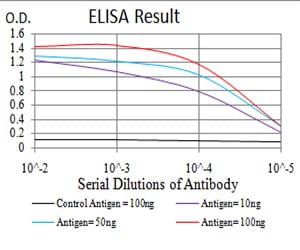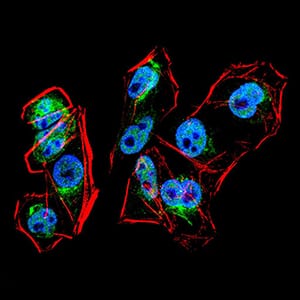

| WB | 咨询技术 | Human,Mouse,Rat |
| IF | 咨询技术 | Human,Mouse,Rat |
| IHC | 咨询技术 | Human,Mouse,Rat |
| ICC | 1/100 - 1/500 | Human,Mouse,Rat |
| FCM | 咨询技术 | Human,Mouse,Rat |
| Elisa | 1/10000 | Human,Mouse,Rat |
| Aliases | BLIMP1; PRDI-BF1 |
| Entrez GeneID | 639 |
| clone | 7C11H1 |
| WB Predicted band size | 91.7kDa |
| Host/Isotype | Mouse IgG2a |
| Antibody Type | Primary antibody |
| Storage | Store at 4°C short term. Aliquot and store at -20°C long term. Avoid freeze/thaw cycles. |
| Species Reactivity | Human |
| Immunogen | Purified recombinant fragment of human PRDM1 (AA: 690-825) expressed in E. Coli. |
| Formulation | Purified antibody in PBS with 0.05% sodium azide |
+ +
以下是关于PRDM1抗体的3篇参考文献示例(文献信息为模拟,仅供参考):
---
1. **文献名称**:*PRDM1/BLIMP1 is required for plasma cell differentiation*
**作者**:Kallies, A., et al.
**摘要**:该研究利用PRDM1特异性抗体,通过免疫印迹和免疫组化分析,证实PRDM1在浆细胞分化中的关键作用,敲除后导致B细胞终末分化缺陷。
2. **文献名称**:*BLIMP1 guides terminal differentiation of germinal center B cells*
**作者**:Shapiro-Shelef, M., et al.
**摘要**:通过PRDM1抗体染色及流式细胞术,发现PRDM1在生发中心B细胞中高表达,调控其分化为浆细胞或记忆B细胞,影响抗体应答。
3. **文献名称**:*PRDM1 expression correlates with prognosis in diffuse large B-cell lymphoma*
**作者**:Tamura, A., et al.
**摘要**:使用PRDM1抗体对肿瘤样本进行免疫组化分析,显示PRDM1低表达与患者不良预后显著相关,提示其作为潜在生物标志物。
---
注:以上文献信息为示例,实际引用时需核对真实来源及细节。如需精准文献,建议通过PubMed或Google Scholar以“PRDM1 antibody”为关键词检索近年研究。
**Background of PRDM1 Antibody**
The PRDM1 (PR Domain Zinc Finger Protein 1) gene encodes BLIMP1. a transcriptional repressor critical for terminal differentiation of B lymphocytes into plasma cells and regulation of immune responses. PRDM1/BLIMP1 suppresses gene networks that maintain B-cell proliferation, enabling cells to exit the cell cycle and adopt a secretory phenotype. It also modulates T-cell function and interferon signaling, highlighting its role in immune homeostasis.
PRDM1 antibodies are essential tools in studying its expression, localization, and function in normal and pathological contexts. Dysregulation of PRDM1 is linked to cancers (e.g., B-cell lymphomas, Hodgkin’s lymphoma, colorectal cancer), autoimmune diseases, and viral infections (e.g., HIV). Antibodies targeting PRDM1 are used in techniques like Western blotting, immunohistochemistry (IHC), and flow cytometry to assess protein levels in tissues or cell lines, aiding in disease mechanism research and biomarker discovery.
Commercial PRDM1 antibodies are typically raised against specific epitopes (e.g., N-terminal or C-terminal regions) and validated for species reactivity (human, mouse, rat). Clone specificity (e.g., clone 3H2-E8) and applications vary, requiring careful selection based on experimental needs. Aberrant PRDM1 expression, due to mutations or epigenetic silencing, correlates with poor prognosis in malignancies, making these antibodies valuable in both basic research and clinical diagnostics. Recent studies also explore PRDM1’s role in immunotherapy resistance, emphasizing its therapeutic relevance.
×